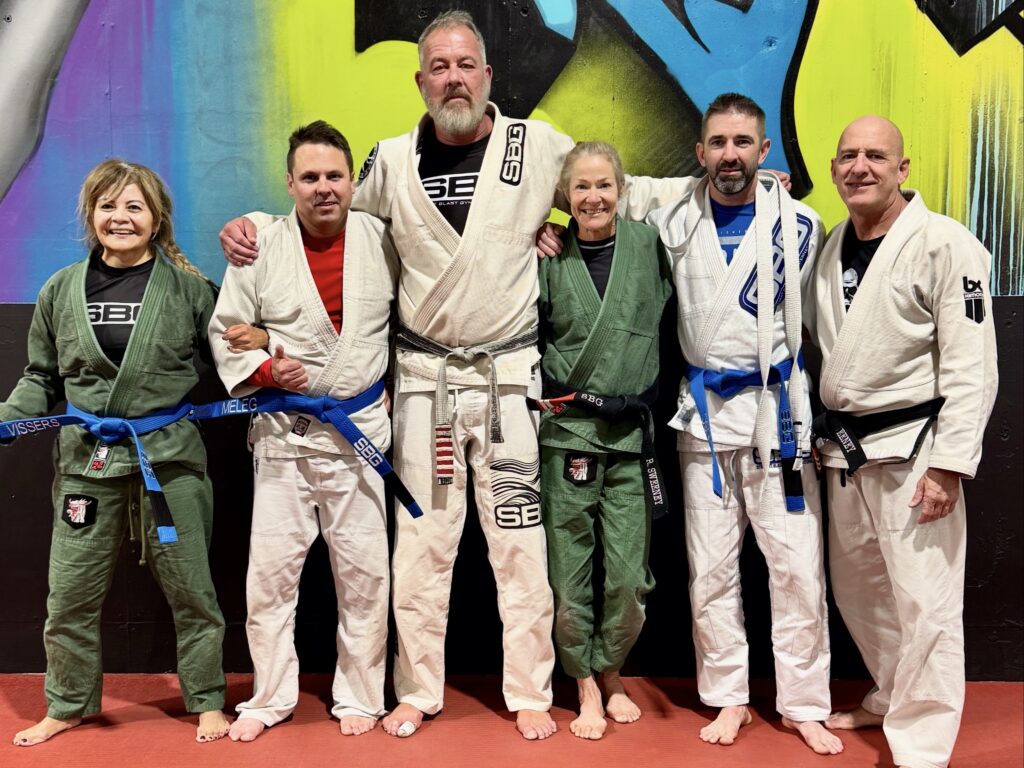Short answer: Most beginners in Calgary can earn a blue belt in 18 to 36 months. Your timeline depends on attendance, consistency, coach feedback, and staying healthy.
If you are weighing BJJ vs the gym, this guide shows what affects your timeline, what blue belt means, and how to set up your first 90 days for success.

What affects your blue belt timeline?
Short answer: Consistency beats intensity.
- Attendance: Two classes per week result in steady progress. Three or more classes can accelerate progress.
- Mat time quality: drill intelligently, apply progressive resistance.
- Fundamentals: focus on base, posture, positional escapes, and guard retention.
- Coach feedback: learn to apply skills safely with different partners.
- Mindset: tap early, ask questions, enjoy the process.
- Recovery: sleep, hydration, and injury prevention keep you training.
What does blue belt mean at SBG Calgary?
Short answer: You can reliably apply fundamental skills against your peers and understand how to train safely with partners.
- Solid escapes from common pins and back control
- Basic guard retention and passing concepts
- Clean positional control and transitions
- A handful of high-percentage takedowns, sweeps, and submissions
- Partner safety is priority #1
How often should I train?
Short answer: Start with two classes per week. Talk to a coach if you feel ready to train more often.
As a rule of thumb, two sessions per week let you recover and keep life in balance.. A third day helps you connect ideas faster. Over 40? Stay consistent and scale intensity.
How long will it take me personally?
Short answer: Use attendance as a guide, then factor in recovery and coaching.
Attendance vs typical timeline
| Weekly classes | Typical path |
|---|---|
| 1 class | Progress will be slower but still achievable. Promotions will generally take longer than 36 months. |
| 2 classes | Common path. 18 to 36 months depending on consistency. |
| 3 classes | Faster path if recovery is solid. Often closer to 18–24 months. |
Your first 90 days: simple plan
Short answer: Build a routine, learn the fundamental movements, communicate with your coach, and keep training light and consistent. Focus on foundational skills.
- Weeks 1–4: Build your base
Routine: Aim for two classes each week. Arrive 10 minutes early.
Safety culture: Tap early, breathe, and tell partners if anything feels off.
Mat etiquette: Clean gear, trimmed nails, wear shoes when off mats, quick fist bump.
Movement bank: hip escape, bridge, technical stand-up, threading the needle, breakfalls, shoulder rolls.
Positions to learn: mount, side control, back control, closed guard.
Concepts: proper posture, and move yourself before trying to move your partner.
Notes: After class, write one thing that worked and one thing to ask next time. - Weeks 5–8: Make simple skills reliable
Consistency: keep two classes per week.
Partner variety: train with partners of different sizes and levels to learn timing and comfort.
Small toolkit: one takedown, one mount escape you trust, one side control escape, one guard pass, one submission.
Grips and posture: learn where your hands go in guard and in top positions.
Coach feedback: ask for one specific focus each week, for example “keep elbows in during escapes.”
Recovery habits: sleep, water, easy walking on non-training days. - Weeks 9–12: Connect the dots
Attendance: continue attending two classes per week, speak to your coach if you’d like to train more.
Link movements: For example: takedown → guard pass → mount → back control → choke.
Timing under guidance: when coaches introduce controlled drills, apply the fundamentals you have been taught.
Calm body: breathe through your nose, relax your grip, and use only the energy you need.
Self-check: can you show a beginner one escape, one guard pass, and how to stand-up safely?
Coach check-in: consider scheduling a private lesson.
Materials: a clean Jiu Jitsu gi and a water bottle.
Outcome by day 90: you have a steady routine, a reliable movement bank, and enough fluency to enjoy training and improve each week.
Common roadblocks and quick fixes
Short answer: Plan for life, not a perfect schedule.
- Missed weeks: book your next class today. Discipline beats motivation!
- Sore or injured: tell your coach and ask how to modify training. Keep it technical and calm.
- Over-sparring: ask your coach how to scale back intensity and increase technical drilling.
- Perfectionism: pick one escape and one pass to improve this month.
- Plateau: train with different partners, take notes, consider a private lesson.
Do stripes matter?
Short answer: They mark progress, not the destination.
Stripes help you see steady improvement. The goal is reliable skills, safe training, and a body that can train tomorrow.
Should I lift or do extra cardio?
Short answer: You can. Keep it simple.
If you enjoy lifting, do one or two short sessions around BJJ days. Walking, biking, or light intervals are great on non-mat days. Prioritise sleep so you can train consistently.
Is BJJ safe for beginners or over 40?
Short answer: Yes. We scale intensity, match partners thoughtfully, and prioritise longevity.
Tell us about old injuries. We will coach around them. Tap early and often, and you will do well.
Why train at Straight Blast Gym Calgary?
Short answer: Beginner-first coaching, supportive Tribe, and a plan that works.
You will learn from experienced black belt coaches in a supportive community near Marlborough Mall. We keep classes structured and partner matching thoughtful so you feel comfortable on day one and confident by week four.
Ready to start?
Short answer: Book a free, no-pressure intro and we will make your first visit easy.
- Book a free intro: https://sbgcalgary.com/intro/
- See class times: https://sbgcalgary.com/#schedule
- Call us: (587) 742-2022
- Location: near Marlborough Mall in Calgary
FAQ: Blue Belt in BJJ (Calgary)
Most beginners can earn a blue belt in 18 to 36 months, depending on attendance, consistency, and coach feedback.
Two classes per week is a sweet spot. Add a third class when you feel ready and are recovering well.
No. Competition is optional. Promotions are based on reliable fundamentals, mat awareness, and safe training with different partners.
Yes. We scale intensity, match partners carefully, and introduce live rounds gradually.
Stripes mark progress and help coaches track development, but the focus is your skill and safety with partners.
Clean t-shirt and athletic shorts, jogging pants, or leggings.
